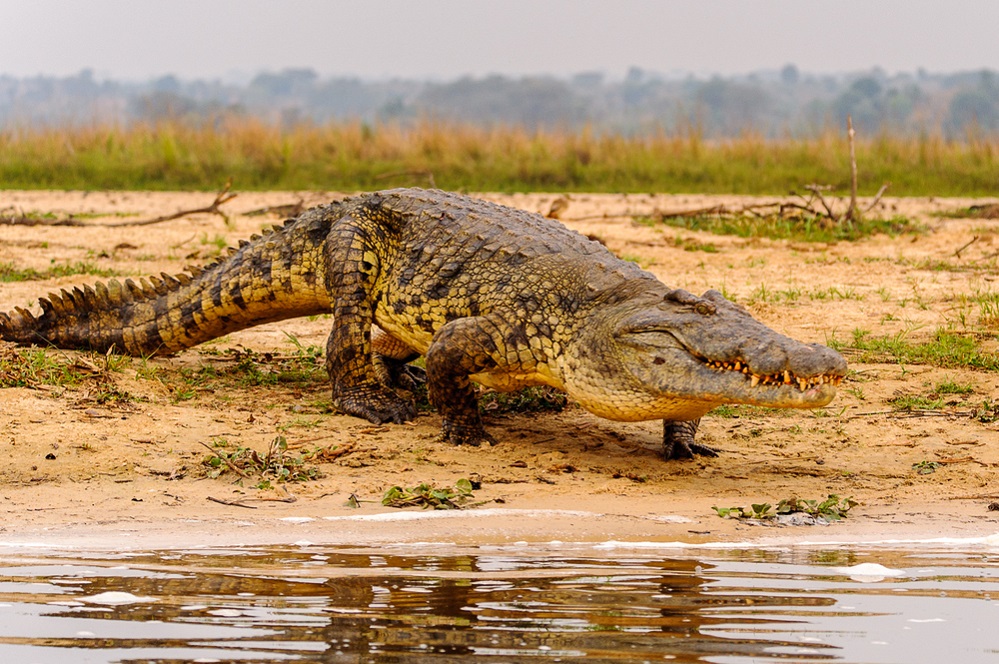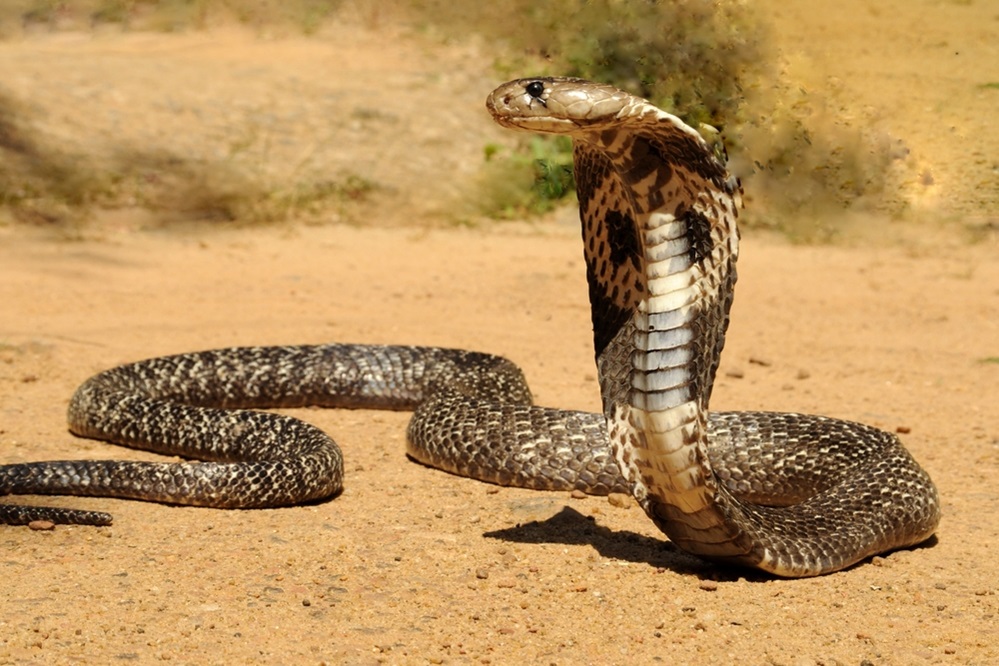Imagine a giant reptile with a long, powerful body, scaly skin, and a massive jaw full of sharp teeth, that’s a crocodile. They are impressive creatures that have been around for millions of years, changing very little from their prehistoric ancestors.
Crocodiles are like living links to the past. They roamed the earth alongside dinosaurs and have survived incredible changes over time. Their amazing adaptations have helped them thrive in rivers, lakes, and even coastal waters.
Crocodiles aren’t just found in one place, they live across the globe in warm, tropical regions of Africa, Asia, Australia, and the Americas.
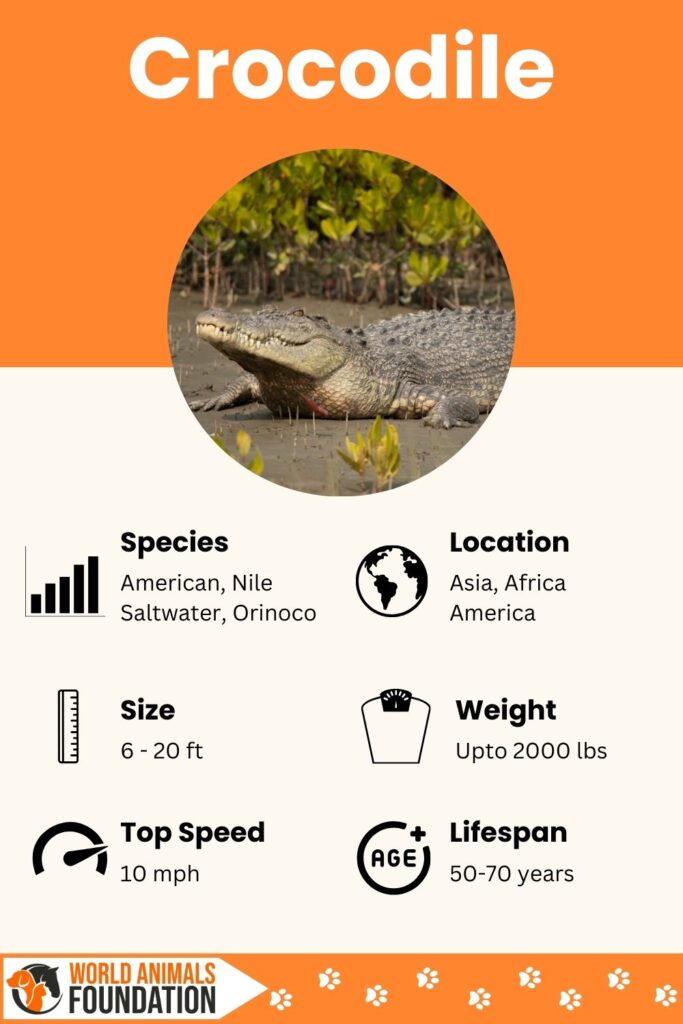
Crocodile Species and Distribution
Not all crocodiles are the same! There are different species living in various parts of the world, each with its own unique features.
Saltwater Crocodile

The saltwater crocodile is the biggest of them all and can even handle living in salty ocean water. Saltwater crocs inhabit coastlines and rivers in Asia and Australia. They are known for their immense size, reaching up to 20 feet long, and sometimes pose a danger to people.
Nile Crocodile
The Nile crocodile is another massive croc, living in the rivers and lakes of Africa. They’ve been an important animal in African history and even worshipped by ancient cultures.
American Crocodile
You have the American crocodile found in parts of North, Central, and South America. These massive reptiles can grow up to 20 feet long, weighing a staggering 2,000 pounds – definitely not an animal you want to mess with. While they’re undeniably intimidating, American crocs are generally less aggressive towards humans than some of their cousins.

You’ll mostly find these impressive creatures lurking in coastal areas, with South Florida being a particular hotspot. Observers have spotted American crocodile populations across Mexico, Peru, and Venezuela as well.
Orinoco Crocodile
The Orinoco crocodiles are fresh water crocodiles and one of the most critically endangered, inhabits the Orinoco River basin in South America.
There are also smaller species like the dwarf crocodile in West Africa and many more across the globe!
Crocodile Behavior
Crocodiles are masters of the hunt and true top predators in their environments. They’re experts at the sneak attack, lying in wait just below the water’s surface with only their eyes and nostrils showing. This camouflage lets them ambush unsuspecting animals that come to drink or cross the water. With a powerful thrust and a snap of their jaws filled with sharp teeth, they can capture their prey in an instant.

Crocodiles aren’t picky eaters. Their diet includes fish, birds, various mammals like deer, antelope, or even buffalo if they’re big enough. They sometimes even take down other reptiles like snakes or turtles! Larger crocodiles won’t hesitate to target big prey like zebras or wildebeest.
Crocodiles mostly like to keep to themselves. You won’t find them hanging out in big groups like some animals. But they might tolerate other crocs if there’s lots of food around. They can be very territorial, though, and might fiercely fight other crocodiles who invade their favorite spots in the river or lake.
Crocodiles communicate in different ways to send messages to each other. A hissing crocodile means “back off!” During the breeding season, males make deep, booming bellows to attract females and warn off rival males. They also use body language like head slaps and tail thrashing to show who’s boss or when they feel threatened.
The Importance of Crocodiles
Crocodiles might seem scary, but they play a super important role in their environments! They’re like the big bosses of their rivers, lakes, and coastal areas, keeping the populations of other animals in check. By eating fish, mammals, and birds, they help make sure no single animal type becomes too numerous and disrupts the balance of the ecosystem.
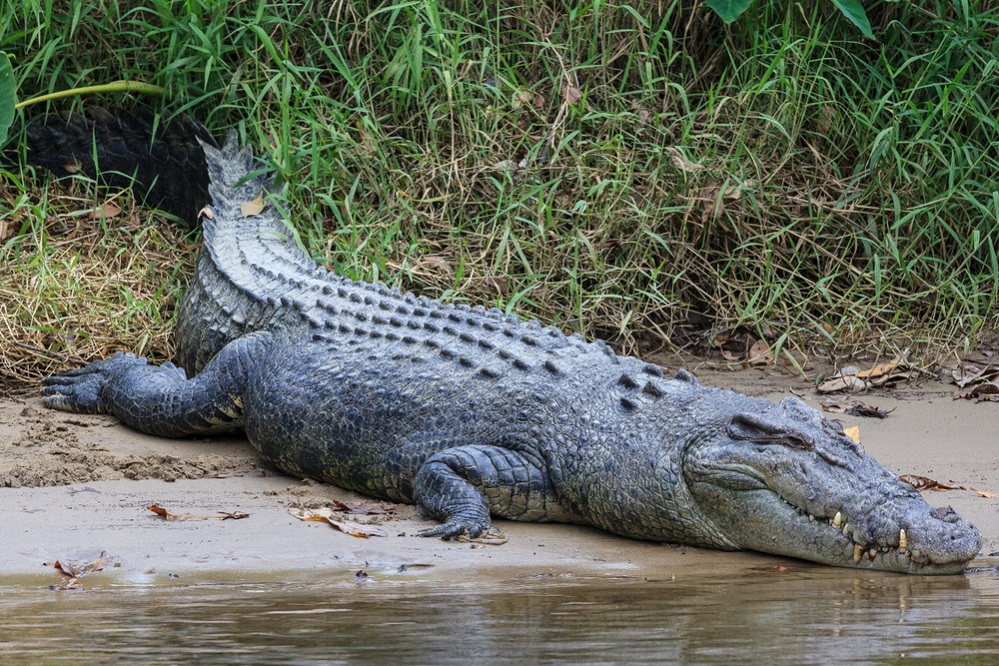
When crocodiles leave pieces of their meals behind, they’re not just being messy! Those leftovers become snacks for a whole range of other animals, like fish, birds, and even insects. This helps nutrients and energy flow throughout the entire ecosystem, benefiting many different creatures.
Crocodiles have been around for a truly long time that they’ve popped up in stories and legends for centuries. Some ancient cultures even worshipped them, seeing them as powerful symbols.
Today, crocodiles can represent many things: power, a connection with the prehistoric past, and sometimes even danger. These fascinating creatures leave a lasting impression on the human imagination.
How Long Do Crocodiles Live?
You might picture crocodiles as fierce predators, but did you know they’re also champions of longevity? While exact lifespans vary by species, many crocodiles in the wild can live 50-70 years. Saltwater crocodiles can live for over 100 years!

Several factors impact a crocodile’s lifespan:
Threats and Dangers: Habitat loss, hunting (both historical and present-day), and conflicts with humans sadly shorten the lives of many crocodiles.
Natural Challenges: Even in ideal habitats, crocodiles face risks. Competition for food and territory, disease, and injuries from other animals can impact their longevity.
Species Differences: Smaller crocodile species tend to have slightly shorter lifespans compared to the giants like the Nile and saltwater crocodiles.
Despite these challenges, the oldest known crocodiles on record serve as a testament to their resilience and adaptability. Lolong, a saltwater crocodile in the Philippines, lived to be a centenarian, and a Nile crocodile in Botswana is estimated to have reached the incredible age of over 120 years!
Compared to humans, crocodiles have a significant lifespan advantage. Crocodiles demonstrate their evolutionary success through remarkable longevity, having survived and thrived for millions of years.
Crocodile Myths and Legends

Crocodiles have fascinated and sometimes terrified humans for centuries. People have passed down countless myths and legends about crocodiles for generations.
One old myth suggests that crocodiles cry while eating their prey, giving rise to the expression “crocodile tears” to describe fake sadness. In reality, crocodiles do release fluids from their eyes while eating, but this is more likely a physiological response to help them swallow and digest their food.
Ancient Egyptians held crocodiles in a mix of fear and reverence. Ancient Egyptians revered the crocodile god Sobek, associating him with both fertility and the dangers of the Nile. They sometimes mummified crocodiles and offered them as sacrifices.
Crocodiles continue to hold symbolic power in many cultures, featuring prominently in folktales. Some stories may cast them as wise tricksters, dangerous monsters, or guardians of sacred places.
Crocodiles and Humans
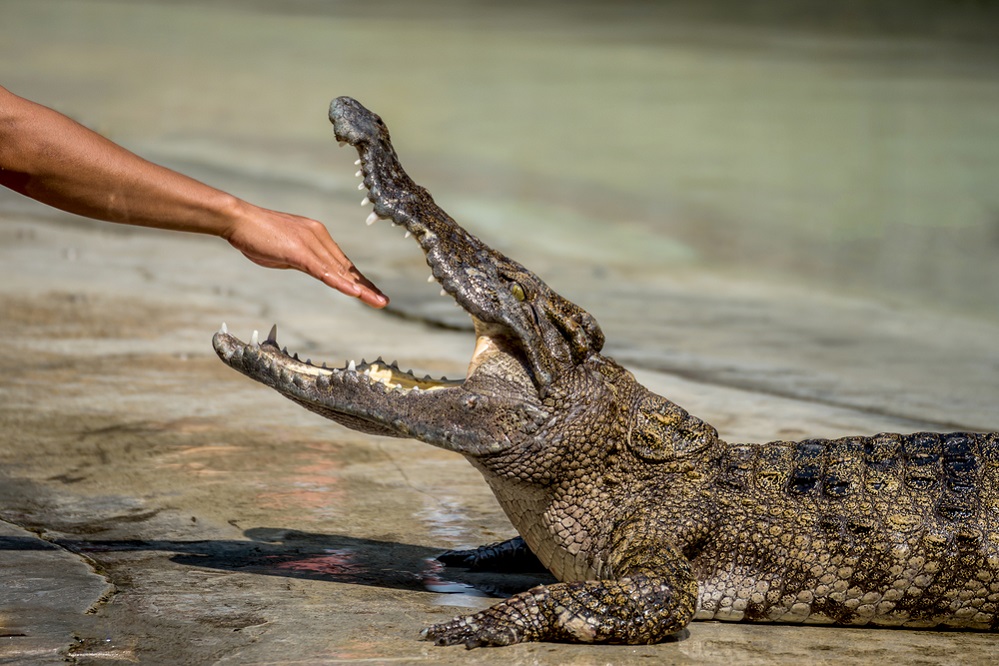
Crocodile is a wild animals with powerful instinct, and it’s important to remember that they can be dangerous. They possess incredibly powerful bites and have attacked humans, especially when feeling threatened, defending nests, or mistaking a person for prey. Always stay alert and aware of your surroundings in areas where crocodiles might be present.
If you live in or are visiting an area with crocodiles, there are important things you can do to stay safe. Learn about local wildlife before exploring rivers, lakes, or swamps. Pay close attention to warning signs and never swim or walk in areas where crocodiles might be present. If you do encounter a crocodile, the safest thing to do is back away slowly and maintain a safe distance. Never approach a crocodile or try to interact with it.
Humans and crocodiles have a long and complicated history. In some places, people have hunted crocodiles for their skins or meat, sadly hurting their populations. While crocodile attacks on humans receive a lot of attention, these incidents are actually quite rare considering how often people and crocodiles interact without conflict.
Finding a balance where humans and crocodiles can coexist safely is important. Education about crocodile behavior, respecting their space, and implementing responsible safety measures are key to protecting both humans and these fascinating creatures.
Crocodile Conservation

Crocodiles face several challenges in the modern world. One of the biggest problems is habitat loss. As human populations grow and development expands, wetlands, rivers, and other areas crocodiles call home are being drained, filled in, or polluted. This shrinking habitat makes it harder for crocodiles to find food and nesting sites, and can force them into closer contact with humans, increasing conflict.
Another major threat is hunting. Hunters extensively targeted crocodiles in the past for their tough hides, which they used to make leather goods like purses and shoes. While international trade restrictions have helped curb this practice, illegal hunting for meat and skins still occurs in some areas. Additionally, some communities may hunt crocodiles out of fear due to a lack of understanding about these animals.
Luckily, there are positive changes happening too! Laws have been passed in many countries to make it illegal to hunt or harm most crocodile species. These laws help to protect crocodile populations and allow them to recover from past declines.
Scientists are also playing a vital role in crocodile conservation. They study crocodile populations, behavior, and habitat needs to develop science-based conservation plans. This research helps us understand how many crocodiles there are, where they live, and the challenges they face.

An important part of crocodile conservation is helping people and these amazing creatures coexist safely. Educational programs teach people about crocodile behavior, their ecological importance, and ways to minimize conflict. This can help reduce fear and encourage communities to appreciate crocodiles as valuable parts of their ecosystems.
In some areas, ecotourism focused on crocodiles is creating a win-win situation. Tourists pay to see crocodiles in their natural habitat, which brings money into local communities. This income can then be used to fund conservation efforts like habitat protection and anti-poaching patrols.
Responsible ecotourism also helps raise awareness about the importance of crocodile conservation. By working together, scientists, conservation organizations, and local communities can ensure that crocodiles continue to thrive in their natural habitats for generations to come.
Difference Between Alligator and Crocodile

While alligators and crocodiles might both look like big, scaly reptiles, there are key ways to tell them apart! One of the easiest differences to spot is their snouts. Alligators have a broad, U-shaped snout, while crocodiles have a longer, V-shaped snout.
Another telling sign is their teeth. When an alligator closes its mouth, you usually don’t see its bottom teeth. Crocodiles, on the other hand, have an interlocking jaw where some of their lower teeth are visible even when their mouth is closed, creating a toothy grin!
Alligators and crocodiles also differ in their preferred habitats. Alligators generally prefer freshwater lakes, rivers, and swamps. Crocodiles are more adaptable and can thrive in saltwater environments like coastal areas or estuaries. This difference is due to special glands that crocodiles possess, allowing them to excrete excess salt.
So, which is more dangerous, alligator or crocodile? While both crocodiles and alligators can be dangerous if provoked, crocodiles often have a reputation for being more aggressive toward humans. It’s important to remember that both species are wild animals and deserve respect and caution.
17 Interesting Facts About Crocodiles
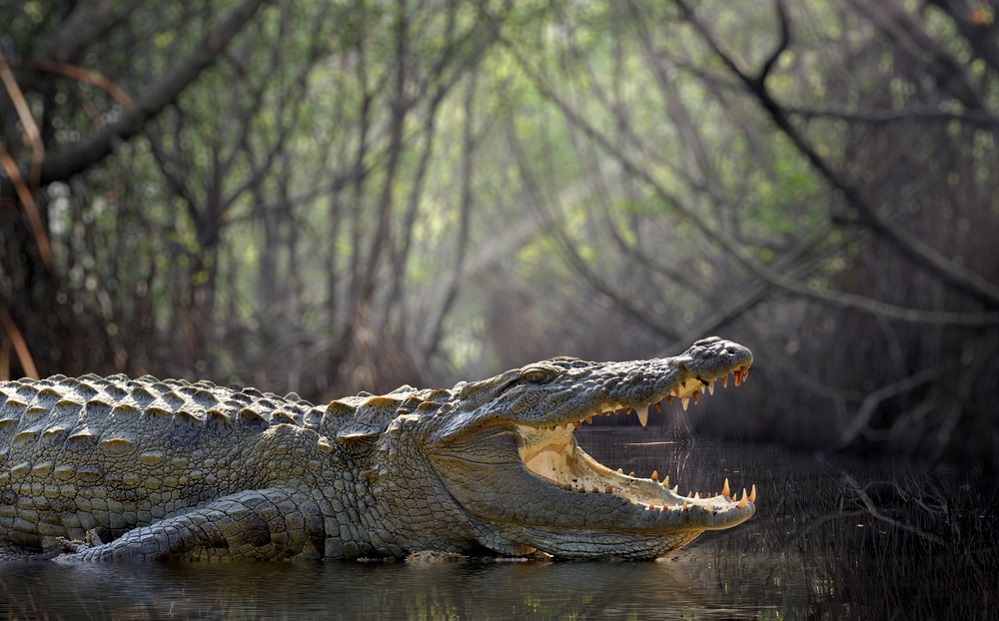
- Crocodiles have one of the most powerful bites in the animal kingdom, capable of crushing bones and turtle shells!
- Crocodiles are closely related to dinosaurs and have changed very little in millions of years – they are true living fossils.
- Saltwater crocodiles are the largest of all living reptiles and can grow up to 20 feet long and weigh over 2,000 pounds.
- Crocodiles can hold their breath for surprisingly long periods, sometimes staying underwater for over an hour.
- Despite their size and fearsome appearance, crocodiles can be surprisingly fast on land in short bursts, reaching speeds of up to 10 miles per hour.
- Crocodiles have a complex system of pressure receptors along their jaws that help them detect the slightest movement of prey in murky water.
- Baby crocodiles make adorable chirping sounds to communicate with their mother and with each other.
- Crocodiles are surprisingly long-lived. Some species can live for over 70 years in the wild.

- Crocodiles play a vital role in their ecosystems by keeping populations of fish, turtles, and other animals in check.
- Crocodiles possess a special eyelid, called a nictitating membrane, which protects their eyes underwater while still allowing them to see.
- Unlike humans, crocodiles continually replace their teeth throughout their lifetime.
- The sex of a crocodile hatchling is determined by the temperature at which its egg is incubated in the nest.
- Some species of crocodiles have been observed using tools! They strategically place sticks on their snouts to lure birds who are looking for nesting materials.
- While crocodiles might seem tough, their skin is actually quite sensitive. This heightened sense of touch is especially concentrated on their head and snout.
- Some ancient cultures revered crocodiles as gods or powerful spirits.
- Crocodiles can go for months without eating, surviving on stored fat reserves.
- In some places, crocodile farms sustainably raise these animals for their meat and skins.
FAQs
How long do crocodiles live?
Crocodiles are surprisingly long-lived. In the wild, they can live for 50-70 years, and some individuals have even been recorded to live over 100 years!
Which is the largest crocodile in the world?
This varies depending on the species. The largest, the saltwater crocodile, can grow up to 20 feet long and weigh over 2,000 pounds!
How fast can a crocodile run?
While they might look lumbering, crocodiles can charge in short bursts on land, reaching speeds of up to 10 miles per hour. However, they tire quickly and rely more on ambush for hunting.
What's the difference between crocodiles and alligators?
The easiest way to tell them apart is their snouts. Alligators have a broad, U-shaped snout, while crocodiles have a longer, V-shaped snout. You can also look for teeth – crocodiles have a toothy grin even when their mouths are closed!
Are crocodiles endangered?
The conservation status of crocodiles varies by species. Some, like the saltwater crocodile, have healthy populations, while others, like the Philippine crocodile, are critically endangered.
What should I do if I encounter a crocodile?
If you see a crocodile, the safest course of action is to keep a very wide distance and never approach it. Back away slowly and calmly, and seek local guidance or contact wildlife authorities if necessary.
Where can I see crocodiles safely?
There are many ways to safely see crocodiles. Many national parks and wildlife refuges, especially in warmer regions, offer designated crocodile viewing areas. Guided tours with experienced naturalists are another excellent way to observe these fascinating reptiles responsibly.
Is it legal to keep crocodile as a pet in the United States?
Keeping crocodiles as exotic pets in the United States is typically illegal due to various federal, state, and local regulations. Crocodiles are considered dangerous wildlife, and their ownership is often restricted to licensed zoos, research facilities, and individuals with special permits.
Conclusion
Crocodiles are awe-inspiring creatures, a testament to the power and resilience of nature. With their ancient lineage and impressive adaptations, they have earned their place at the top of the food chain in wetlands across the globe. While it’s important to respect their power and understand the potential dangers they pose, crocodiles are also vital components of their ecosystems.
By learning more about crocodiles, we can move beyond fear and towards a deeper appreciation for their role in the natural world. Whether observing them from a safe distance, supporting conservation organizations, or simply understanding the importance of respecting their habitats, we can all play a part in ensuring that these remarkable reptiles continue to thrive.

